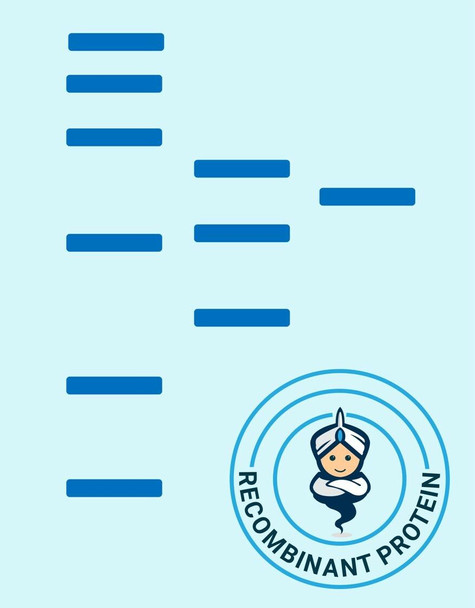Description
| Product Name: | Human FABP4 Recombinant Protein |
| Product Code: | RPPB3498 |
| Size: | 10µg |
| Species: | Human |
| Target: | FABP4 |
| Synonyms: | Fatty acid-binding protein adipocyte, AFABP, Fatty acid-binding protein 4, Adipocyte lipid-binding protein, ALBP, A-FABP, FABP4. |
| Source: | Escherichia Coli |
| Physical Appearance: | Sterile Filtered colorless liquid formulation. |
| Formulation: | FABP4 His-Tag is supplied in 20mM Tris HCL pH=8, 0.5mM DTT and 50% glycerol. |
| Stability: | Store at 4°C if entire vial will be used within 2-4 weeks. Store, frozen at -20°C for longer periods of time.Please avoid freeze thaw cycles. |
| Purity: | Greater than 95% as determined by SDS-PAGE. |
Adipocyte fatty acid binding protein FABP4 is a 15 kDa member of the intracellular fatty acid binding protein (FABP) family, which is known for the ability to bind fatty acids and related compounds (bile acids or retinoids) in an internal cavity. FABP4 is expressed in a differentiation-dependent fashion in adipocytes and is a critical gene in the regulation of the biological function of these cells.In mice, targeted mutations in FABP4 provide significant protection from hyperinsulinemia and insulin resistance in the context of both dietary and genetic obesity. Adipocytes obtained from FABP4-deficient mice also have reduced efficiency of ipolysis in vitro and in vivo, and these mice exhibited moderately improved systemic dyslipidemia. Recent studies also demonstrated FABP4 expression in macrophages upon differentiation and activation. In these cells, FABP4 modulates inflammatory responses and cholesterol ester accumulation, and total or macrophage-specific FABP4 deficiency confers dramatic protection against atherosclerosis in the apoE-/- mice. These results indicate a central role for FABP4 in the development of major components of the metabolic syndrome through its distinct actions in adipocytes and macrophages.
FABP4 Human Recombinant produced in E.Coli is a single, non-glycosylated polypeptide chain containing 132 amino acids and having a molecular mass of 18 kDa. FABP4 is fused to His tag at N-terminus and purified by standard chromatography techniques.
| UniProt Protein Function: | FABP4: a lipid transport protein that is the predominant fatty acid binding protein found in adipocytes. Also expressed in macrophages. Binds both long chain fatty acids and retinoic acid. Delivers long-chain fatty acids and retinoic acid to their cognate receptors in the nucleus. Homodimer. Forms a beta-barrel structure that accommodates hydrophobic ligands in its interior. Interacts with PPARG. Monomer. FABP4 knockout mice fed a high-fat and high-calorie diet become obese but develop neither insulin resistance nor diabetes, suggesting that this protein might be a link between obesity and insulin resistance and diabetes. Mice deficient in both FABP4 and ApoE show protection against atherosclerosis when compared with mice deficient only in ApoE. Mice carrying a FABP4 genetic variant exhibit both reduced FABP4 expression and a reduced potential for developing type 2 diabetes and coronary heart disease. A related study in humans indicated a similar pattern, suggesting that FABP4 may be a potential therapeutic target in the treatment of these disorders. Belongs to the calycin superfamily,fatty-acid binding protein (FABP) family. |
| UniProt Protein Details: | Protein type:Lipid-binding Chromosomal Location of Human Ortholog: 8q21 Cellular Component: cytoplasm; lipid particle; nucleus Molecular Function:transporter activity; fatty acid binding Biological Process: cholesterol homeostasis; transport; white fat cell differentiation; triacylglycerol catabolic process; brown fat cell differentiation; negative regulation of protein kinase activity; cytokine production; negative regulation of transcription, DNA-dependent; positive regulation of inflammatory response |
| NCBI Summary: | FABP4 encodes the fatty acid binding protein found in adipocytes. Fatty acid binding proteins are a family of small, highly conserved, cytoplasmic proteins that bind long-chain fatty acids and other hydrophobic ligands. It is thought that FABPs roles include fatty acid uptake, transport, and metabolism. [provided by RefSeq, Jul 2008] |
| UniProt Code: | P15090 |
| NCBI GenInfo Identifier: | 119781 |
| NCBI Gene ID: | 2167 |
| NCBI Accession: | P15090.3 |
| UniProt Secondary Accession: | P15090,Q6IBA1, |
| UniProt Related Accession: | P15090 |
| Molecular Weight: | 132 |
| NCBI Full Name: | Fatty acid-binding protein, adipocyte |
| NCBI Synonym Full Names: | fatty acid binding protein 4, adipocyte |
| NCBI Official Symbol: | FABP4�� |
| NCBI Official Synonym Symbols: | aP2; ALBP; AFABP; A-FABP; HEL-S-104�� |
| NCBI Protein Information: | fatty acid-binding protein, adipocyte; fatty acid-binding protein 4; adipocyte lipid-binding protein; epididymis secretory protein Li 104; adipocyte-type fatty acid-binding protein |
| UniProt Protein Name: | Fatty acid-binding protein, adipocyte |
| UniProt Synonym Protein Names: | Adipocyte lipid-binding protein; ALBP; Adipocyte-type fatty acid-binding protein; A-FABP; AFABP; Fatty acid-binding protein 4 |
| Protein Family: | Fatty acid-binding protein |
| UniProt Gene Name: | FABP4�� |
| UniProt Entry Name: | FABP4_HUMAN |









